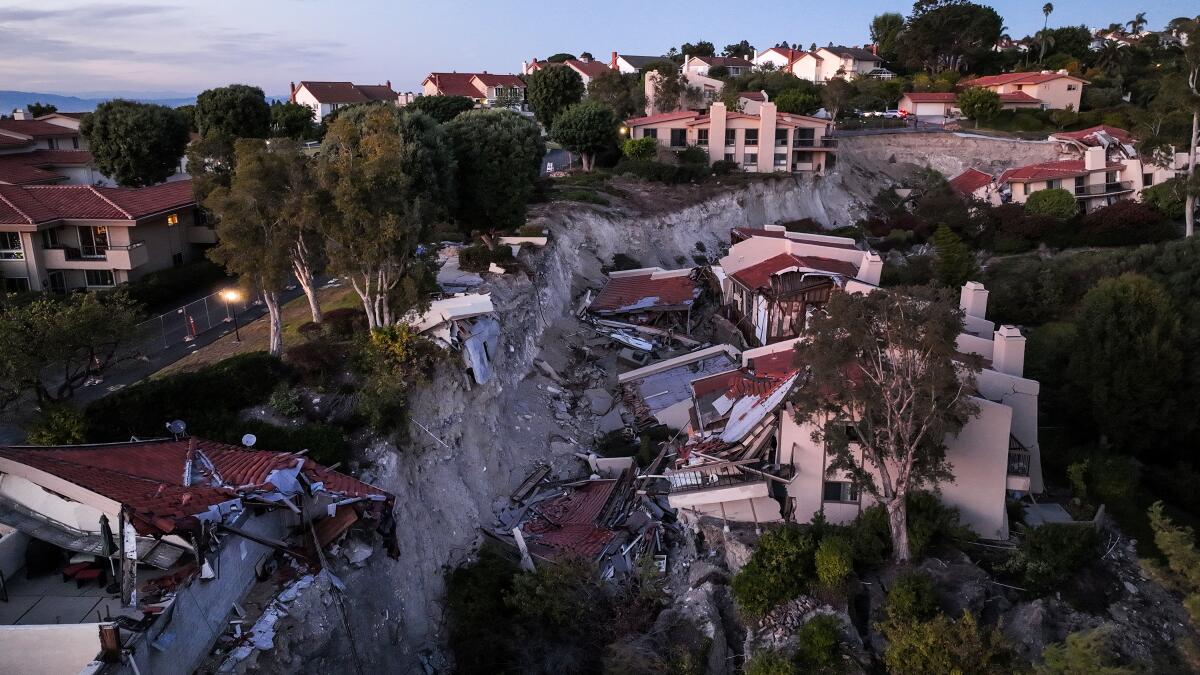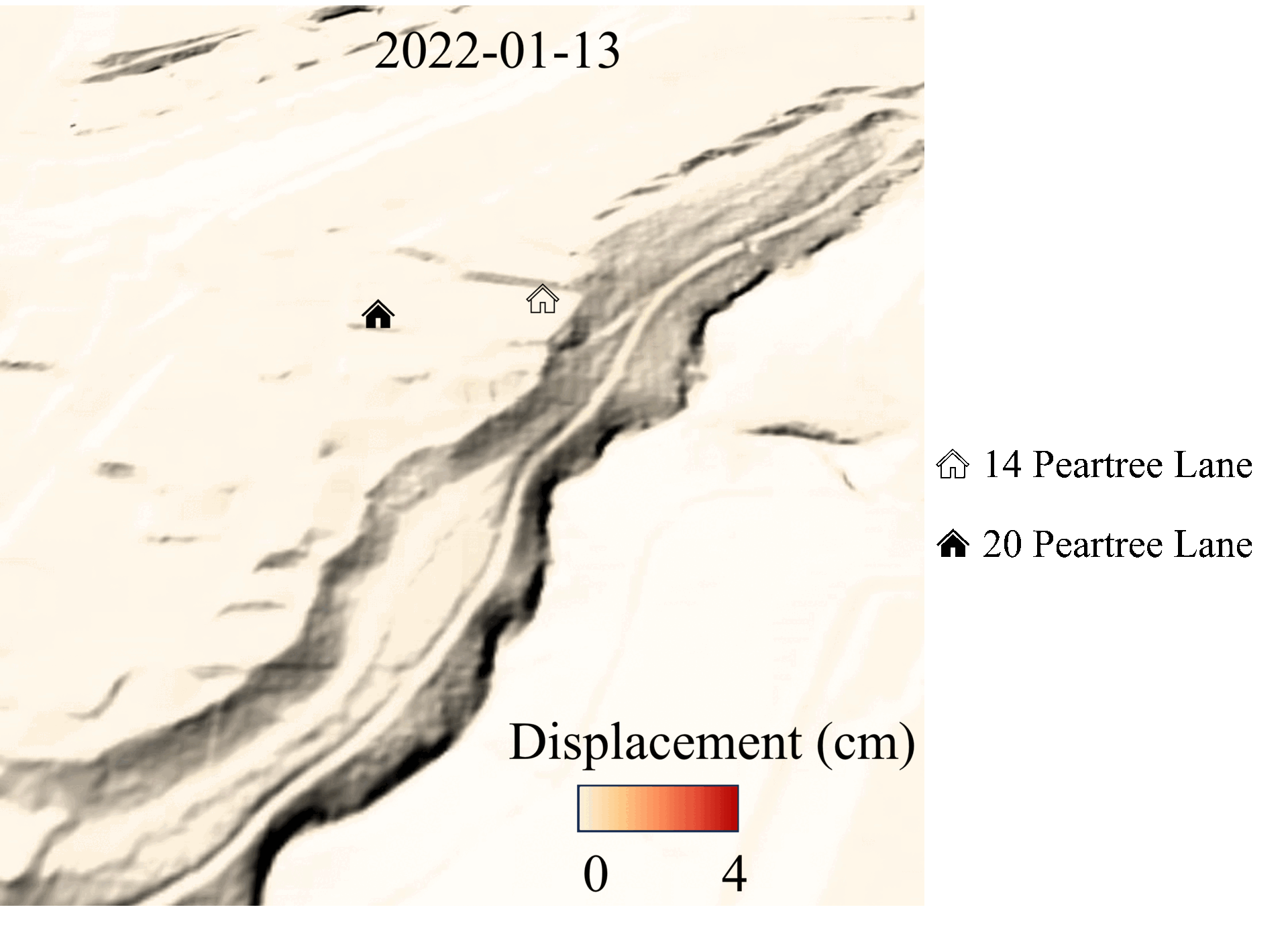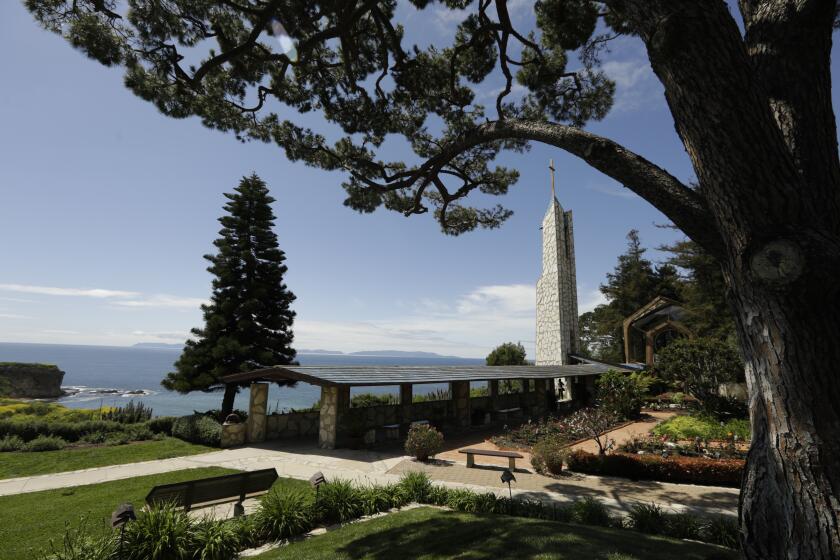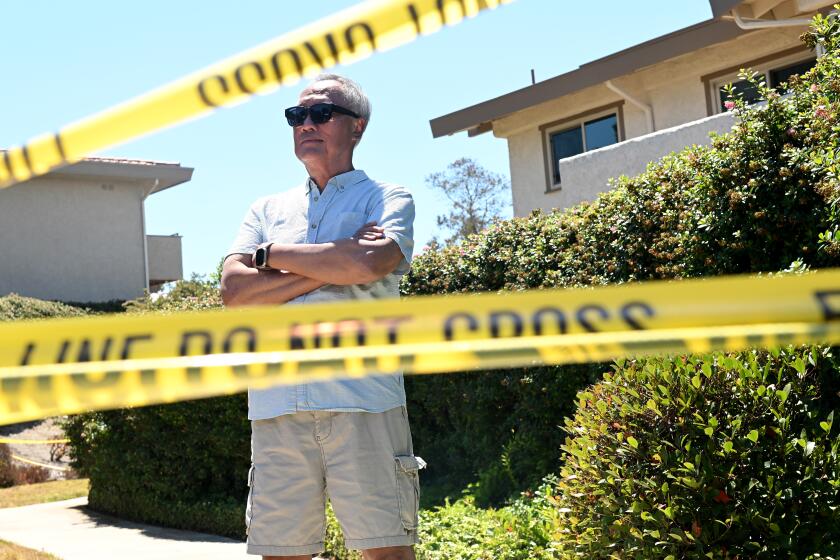Danger signs were present before Palos Verdes landslide destroyed homes, new study finds

Residents on Peartree Lane in Rolling Hills Estates had just minutes to evacuate last summer before the canyon wall on which their homes sat collapsed.
The world soon watched as the red-roofed houses slid quickly down the hillside, cracking, splitting, crumbling.
The landslide on the clear, dry afternoon came as a shock, but new research has found that the slope was actually a “slow-moving, progressive landslide” with foreboding movement that had begun as early as five months before the catastrophic event July 8, 2023.
Analyzing satellite images and data to measure tiny shifts in the land well before that fateful day, the team of researchers was able to gauge the slope’s velocity, then use that metric to calculate — with the obvious gift of hindsight but a high degree of accuracy — when the hillside was due to collapse.
“Our results show that the timing of catastrophic failure of [the Rolling Hills Estates hillside] could have been estimated within a few days of actual failure,” researchers wrote in an article published this month in Geophysical Research Letters. “Our findings provide further evidence that satellite remote sensing data can contribute to landslide early warning systems and can also be used to better understand the impacts of climate change on landslide hazards.”

Experts say more research is needed to utilize this satellite monitoring for large-scale landslide detection, but that’s the ultimate goal. With more testing and technology — and necessary buy-in from public officials — researchers hope this technique could provide enough advance warning to help avert, or at least mitigate, the damage from another such catastrophe.
“If we can record these movements to forecast the potential of the catastrophic failure, it will highly improve hazard management and forecasting,” said Xiang Li, a postdoctoral researcher with UCLA’s Joint Institute for Regional Earth System Science and Engineering and lead author of the study.
Analyzing satellite-based images and data from January 2016 through July 2023 — utilizing a technique known as Interferometric Synthetic Aperture Radar, or InSAR — researchers from UCLA and NASA’s Jet Propulsion Laboratory found measurable movement on the Rolling Hills Estates hillside beginning in February 2023. By that June, they found, the area had moved about 1.6 inches, until it dropped almost 40 feet from July 8 to July 14, destroying at least eight homes and rendering four others unsafe to enter.
A complex mixture of human and geological factors means that this stunningly beautiful peninsula of seaside Southern California homes is also, at times, perilous.
Using the movement data from months before the landslide, the team was able to model potential future movement. Their model predicted that the slope would fail July 11 — three days after the landslide actually failed.
“Here we saw that there are these subtle motions that can provide you with information about pending or future collapse, which is really important,” said Alexander Handwerger, a research scientist at JPL and UCLA’s Joint Institute for Regional Earth System Science and Engineering who was a co-author of the paper. He said these findings can help inform future landslide monitoring and early warning systems, as he works with a team at JPL to build a database with analysis-ready satellite data for the nation.
Handwerger noted that the study found no discernible movement where the Rolling Hills Estates landslide occurred before 2023, setting the slide apart from other nearby, active slides on the Palos Verdes Peninsula, most notably the Portuguese Bend landslide complex, one of the largest slow-moving landslides in the nation. That landslide area has seen recent rapid and damaging acceleration following two winters of above-average precipitation.
And although the makeup of the Rolling Hills Estates slide is different from the others in that region, its movement is also linked to the heavy winter rains that fell months before the collapse, according to a city report. The UCLA and JPL study agreed, finding that the unusually rainy season “played a major factor” in the landslide, but also noting that infrastructure, drainage changes and other human interventions could have affected the land movement.
Just the roof of Weber ‘Wei’ Yen’s home is visible from his street in Rolling Hills Estates. He worries over the mementos he may never get back.
The study also explained the significant lag between the rains, the landslide’s initial movement and its final failure: It’s because instability can take time to build once water infiltrates the ground and creates an internal surface the top layer of land can slide on.
“Formation of the sliding surface will induce some movement, while the collapse will only occur when the sliding surface is fully developed,” Li of UCLA said. “The progression can happen over hours, months or years.”
The study’s findings are of little help to the residents of Peartree Lane, many of whom remain barred from reentering their homes more than a year later, even if they weren’t destroyed, due to stability or sewer issues. The researchers are hopeful, however, that the work can inform early warning systems and landslide forecasting, which could help limit such disasters in the future.
Getting to that point will require further research, as the satellite analysis has proved reliable only in a handful of scenarios — the latest being in Rolling Hills Estates.
“Whether it can be applied widely is questionable,” Li said. There are questions about how this technique will work in different environments around the world, on slopes dense with trees (which makes satellite imaging less accurate) and on slides that don’t have precursory movement.
Geologist El Hachemi Bouali, who wasn’t involved in the research, pointed out that the study used only the land-movement velocity to predict the timing of the failure, so a more nuanced formula that takes into account factors such as geology, slope angle and recent weather may be more reliable — something he could see incorporated in the future using artificial intelligence.
Still, the study’s results are promising, Bouali said. An assistant professor of geosciences for Nevada State University who has long studied landslides on the Palos Verdes Peninsula, he has no doubt that the science and technology for a reliable early warning system for landslides will continue to advance but he worries how feasible such a system would be to implement.
Rolling Hills Estates aims to shore up the slope that failed in July and destroyed eight homes. But as winter approaches, residents fear heavy rain and renewed disaster.
“The biggest hurdle for an early warning system is the cost and the installation of all of the infrastructure you would need,” Bouali said. “Just in L.A. County, you’re probably going to have an inventory of tens of thousands of individual slopes.”
But the work is particularly urgent, as the UCLA and JPL researchers note that climate change is expected to cause more frequent and intense “weather whiplash” — extreme drought followed by extreme rains — which will exacerbate landslides. The long dry stretches can open cracks that let the water penetrate deeper, which can lead to bigger changes in the groundwater pressure during the wet season, the study said.
After another winter of heavy precipitation, neighbors around the Rolling Hills Estates landslide continue to feel on edge, worried about more movement as local officials work to implement added stabilization measures. Although the UCLA and JPL researchers looked only backward in time, Li said he hopes they will be able to extend their analysis going forward.
City officials, however, continue to monitor the site and said in a statement that there has been no indication of any significant new land movement in recent months.
Two separate groups of residents on Peartree Lane have filed lawsuits in Los Angeles County Superior Court, claiming that their neighborhood associations were negligent prior to the landslide, failing to adequately maintain the slope on which their homes sat. One of the cases mentions that residents noticed some cracking at the start of July 2023, but HOA representatives didn’t respond to their concerns.
Attorneys for the HOAs denied the allegations against them in one of the cases, court records show.
Both lawsuits are ongoing. All of the attorneys involved declined — or didn’t respond — to a request for comment from The Times.
More to Read
Sign up for Essential California
The most important California stories and recommendations in your inbox every morning.
You may occasionally receive promotional content from the Los Angeles Times.














